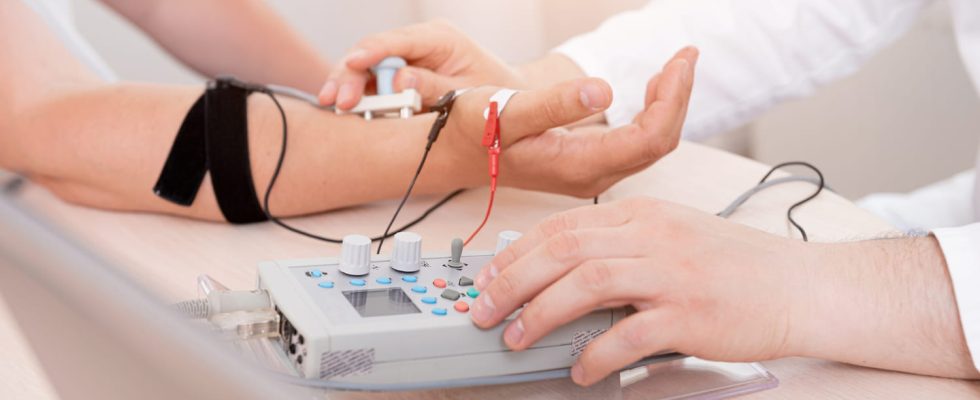An electromyogram (EMG) is a medical test that measures the electrical activity of nerves and muscles, indicated to confirm carpal tunnel syndrome or myopathy for example.
An electromyogram (EMG or electromyography) is a medical examination that allows torecord the electrical activity of nerves and muscles. It is indicated for example to confirm carpal tunnel syndromesciatica, cervical neuralgia, neuropathy related to diabetes or even myopathy.
What is the definition of an electromyogram?
An electromyogram (or EMG) is a medical examination consisting of measure the electrical activity of a nerve in the peripheral nervous system (i.e. which is neither at the level of the brain nor at the level of the spinal cord). “The exam measures nerve conduction velocity and response amplitudes of motor nerves that control muscles and sensory nerves that control skin sensitivity”explains Dr. Antoine Moulonguet, neurologist.
What are the indications of an electromyogram? For which diseases?
“The electromyogram is used to make diagnosis of nerve compressionfor example compression of the median nerve at the carpal tunnel, from the ulnar nerve to the elbow. It is also used to appreciate the impact of the suffering of the nerve roots, for example in the context ofsciatica or cervical neuralgia. It makes it possible to make the diagnosis of diffuse damage to the nerves as in the context neuropathies found in general ailments such as diabetes. It also allows the diagnosis of muscular diseases such as myopathies, says the specialist. The electromyogram is also used for the assessment of perineal painwhich can sometimes correspond to a local compression of the Pudendal nerve in the Alcock canal”, notes the specialist.
What is an electromyogram of the lower limbs used for?
The electromyogram of the lower limbs is used to diagnose:
- Compression of nerves, for example SPE nerve compression (external popliteal sciatica) at the neck of the fibula giving paralysis of the foot.
- More diffuse diseases of the nerves named peripheral neuropathies que can be seen for example in the context of diabetes. The electromyogram can in this case specify the type of nerve damage which can predominate either on the axon or on the myelin sheath.
- As part of a sciatica to specify the affected nerve root in the spine and the degree of severity
What is an electromyogram of the upper limbs used for?
The electromyogram remains the only reliable examination for confirm the diagnosis of carpal tunnel syndrome (compression of the median nerve at the wrist giving diffuse numbness of the hand) with certainty. It allows a measurement the speed of propagation of nerve impulses which is decreased in the carpal tunnel region. “We generally use surface electrodes that we stick to the skin. After having stimulated the nerve with a brief electric current, the response of the muscles of the hand depending on the stimulated nerve appears on the screen of the device in the form of a curve which makes it possible to appreciate the amplitude of the response reflecting the number of fibers activated and the speed of propagation of the nerve impulse” says Dr. Moulonguet. The electromyogram makes the diagnosis of the compression and makes it possible to assess its severity, which is essential for a possible surgical decision.
The electromyogram can be done by private cabinet with a neurologist or to the hospital In a neurophysiology department. The patient should lie down and the neurologist poses electrodes on the areas to be investigated. Of small electrical impulses are sent to study the transmission capacities of the nerve. “A direct exploration of the muscles by means of a small disposable needle completes the exploration” says the neurologist.
How long does this exam take?
The exam lasts 20 to 40 minutes approximately.
Is it painful?
The electromyogram is not not painful strictly speaking: it can be a bit unpleasant for electrically sensitive patients.
What are the risks and side effects?
Electromyogram side effects are very rare but can occur, as with any examination. It can be a vagal discomfort or a minor bruise.
What is the cost of an electromyogram?
The electromyogram costs approximately 170 euros (+/- overshoot) and is supported at 70% based on 120 euro by health insurance.
Thanks to doctor Antoine Moulonguet, neurologist, author under the name of Antoine Senanque of “Healing when it’s impossible” at Marabout editions.
